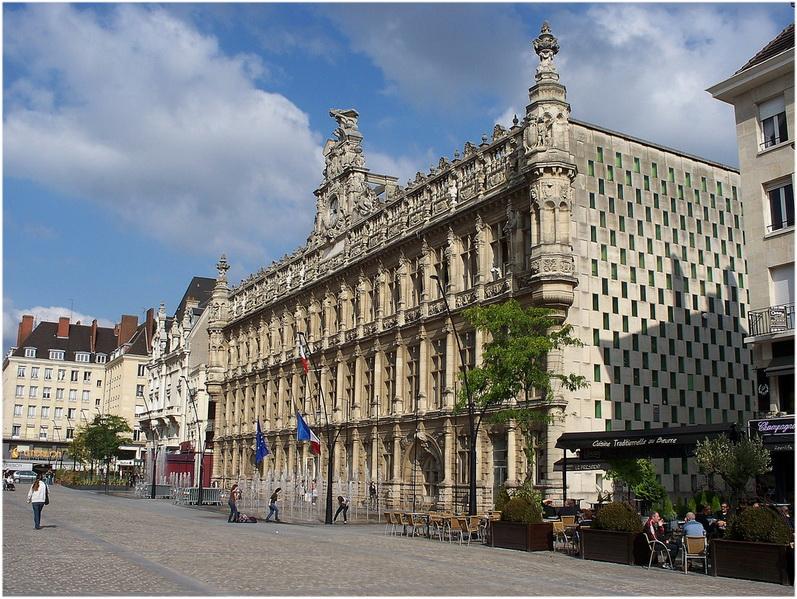Valenciennes, Nord-Pas-de-Calais, France
Valenciennes, whose inhabitants are called the Valenciennois, is a commune in the Nord department, historically the capital of the French county of Hainaut and now a sub-prefecture since 1824, located in the Nord-Pas-de-Calais region of France. It is also located at the confluence of the Escaut and Rhônelle rivers, with a rich cultural past ("the Athens of the North"), and was also a very prosperous industrial and mining town in the 19th century, when the Compagnie des mines d'Anzin opened many pits. The best known is the Du Temple pit, whose reinforced concrete headframe still exists.
Together with Lille and the other towns in the former Nord-Pas-de-Calais mining basin, it is also part of a metropolitan area of almost 3.8 million inhabitants, known as the "Lille metropolitan area". The commune is located 122 km from the North Sea (Dunkirk) and 140 km from the nearest mountainous point (Ardennes). On the other hand, it is close to several European capitals, such as Paris at 200 km, London at 280 km, and Amsterdam at 300 km. In addition, Valenciennes is located on the northern edge of Hainaut (a cross-border region), between the Avesnois and Scarpe-Escaut regional nature parks. It benefits from the proximity of the bocage landscape to the south-east, and 5,000 ha of forests to the north-east, including mainly the Raismes-Saint-Amand-Wallers state forest, for 4,600 ha. The Flanders plain begins beyond, to the north-east of the Scarpe.
On the hydrographic side, the commune is situated between two rivers, the Scheldt and one of its tributaries, the Rhônelle. Five minutes from the town centre, the 54-hectare Vignoble lake offers a natural setting for relaxation and leisure. The Scheldt, while providing an easy transport route, also frequently flooded Valenciennes in the Middle Ages.
Buildings and places of worship
the Notre-Dame-du-Saint-Cordon basilica (1852-1864)
the Sacred Heart Church where the local Sons of Charity are based
the church of Saint-Géry
the church of Saint-Michel
Part of the same deanery and part of the parish of Saint-Vincent de Paul en Valenciennois are
the chapel of Saint Joseph, located in rue du Faubourg de Cambrai
the chapel ofSainte-Bernadette, in the Place des Charbonniers
the Saint-Vaast church, located in rue de Croy.
the Saint-Nicolas church, which was originally the chapel of the Jesuits. Built between 1601 and 1606 to the plans of Henri Hoeimaker, its façade was modified in the 18th century while its interior was redesigned. It is now a theatre.
The restoration of the church of Saint-Géry was completed in 1965 (following the damage caused by the Second World War).
The parishes of Saint-Géry and Saint-Nicolas were then merged. Afterwards, the faithful of the new parish had to go exclusively to St. Géry's church, since St. Nicolas' was transformed into an auditorium after its disuse.
Protestants and Evangelicals
The Evangelical Church of Valenciennes, located in Rue du Chauffour, is affiliated to the Assemblies of God. It was founded in March 1940.
Mormons
The Church of Jesus Christ of Latter-day Saints.
Synagogue of Valenciennes
The presence of a Jewish community is attested in the city since 1789, and there are about twelve people, divided into two families. A room dedicated to prayer was bought in 1849 and allowed the community to stop using a room in a private home. This synagogue predates the one in Lille (1891).
Islam
There are many mosques and prayer halls in the Valenciennes area, the most important of which is the Great Mosque of Valenciennes in the Rue François-Colliez in the south of the town.
Art and the town
A city of the arts, Valenciennes is proud of the forty or so Prix de Rome winners from its academic schools and its National Conservatory of Music, which earned it the nickname "Athens of the North" in 1860. The collections of the Musée des Beaux-Arts show the inclination of the Northern schools in the 16th and 17th centuries for landscape, still life and portraiture.
Related articles
30 (great) ideas for your next hikes in France

Overseas: the islands of France
What are the 20 sunniest cities in France?
Discover the 20 hottest cities in France

What to eat in France: typical dishes, tips and curiosities about French cuisine

Urbex: discovering abandoned places across France and Europe
The ranking of the most expensive cities in France in 2024

Auchel, Nord-Pas-de-Calais-Picardie, France


